A record diagram is a pictorial model students can depict to represent a mathematical relationship or to develop understanding of a math concept. Record diagrams are useful for solving many different types of math problems just are commonly used with word problems. Students can use a tape diagram to organize information and communicate their mathematical thinking.
Start with tape diagrams early.
Eureka Math ® introduces tape diagrams as early on every bit Grade 1 with addition and subtraction to reinforce the part–whole relationship. The employ of tape diagrams supports students' transition from concrete models to representational and symbolic models. The following Class 1 instance shows how to introduce students to using record diagrams. Students can probable represent 6 + 7 by drawing dots. When you draw rectangles around the dots representing the addends and betoken the sum with a question mark, you've fabricated a tape diagram that reinforces the function–whole nature of the quantities. Students brainstorm to realize how the two parts come together to make a whole—the box gathers all the dots into one group; they do non appear simply as xiii detached objects. This activity lays the foundation for the Grade 2 example, in which they start to explore equal parts. One time students know how to depict record diagrams, they can use them to make sense of many mathematical relationships.
| Course 1: Addition | Form two: Making Equal Groups |
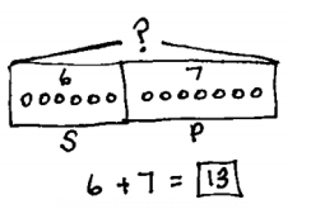 | 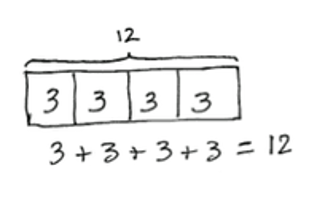 |
Tape diagrams are useful at all course levels.
When students run into new challenges, the tape diagram tin exist a familiar place to showtime. What once helped with basic whole number arithmetic in primary grades extends to fractions in intermediate grades and even algebra in heart and high school. Let's expect at how students can apply tape diagrams to help them make sense of those concepts.
Showtime, we'll encounter how students tin can apply the tape diagram to empathize operations with fractions in this example from Grade 5.
Ms. Hayes has ½ liter of juice. She distributes it equally to 6 students in her tutoring group. How many liters of juice does each student get?
| Notice how the tape diagram represents the problem. A larger rectangle represents a whole liter. That rectangle is partitioned to evidence half liters. And then each half liter is partitioned to represent the amount each educatee gets. The drawing makes meaning of division problems clear in a way that inverting and multiplying does not. | 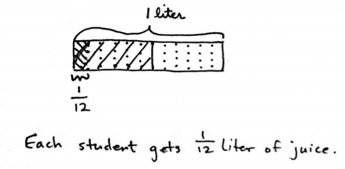 |
Next, allow's expect at an case of an algebraic problem from Class 7.
Jenny is on the local swim team for the summer and has swim practice four days per week. The schedule is the same each day. The squad swims in the morning then once more for ii hours in the evening. If Jenny swims 12 hours per week, how long does she swim each morning time?
| In this case, the tape diagram shows the 4 days of practice, each with an unknown morn practise time, and 2 hours of practice in the evening. Students tin can apply a tape diagram to aid write an equation such every bit four(x + 2) = 12. They may also work backward, subtracting the 8 hours inside the tape from the 12 total hours, and and so divide the four hours every bit among the 4 sections to see that each represents one hour. |  |
Finally, let's look at an Algebra I trouble.
5 years from now, the sum of the ages of a woman and her daughter will be 40 years. The difference in their present historic period is 24 years. How quondam is her girl now?
| This is a expert case of how a tape diagram helps students organize information. The first department of each tape represents 5 years from now. The adjacent section represents the girl'due south historic period at present. The last department of the peak tape shows the current age difference, and both tapes together stand for the total. Students employ this drawing to write an equation to find the sum of each section. For instance, five + x + 24 + five + x = 40 or 2x + 34 = 40. | 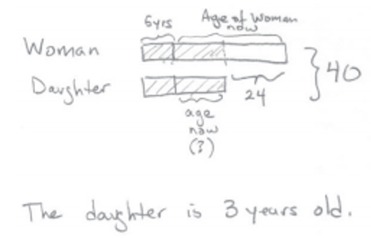 |
You lot can innovate students to tape diagrams at any time.
If your students are just beginning to use Eureka Math, you may wonder how to introduce them to tape diagrams if they didn't utilise them in previous years. Consider doing one entire lesson on tape diagrams. During this lesson, use problems from previous grades to go along the focus on understanding tape diagrams and not on learning a new math concept. Y'all'll be surprised how chop-chop students empathize the model. In fact, students usually embrace information technology more quickly than teachers, probably because they accept fewer years of doing things differently to overcome.
Another suggestion is to scaffold the offset problems that students represent with tape diagrams. For instance, let's revisit the Grade 5 problem we looked at previously.
Ms. Hayes has ½ liter of juice. She distributes information technology equally to vi students in her tutoring grouping. How many liters of juice does each student get?
| Utilise the following questions to scaffold the problem to support students in representing it. - How tin can yous evidence ½ liter on a tape diagram? What is the whole liter and how can you show ?
- How tin you lot testify that Ms. Hayes distributes the juice as to 6 students?
- What part of the whole liter does each student get?
| 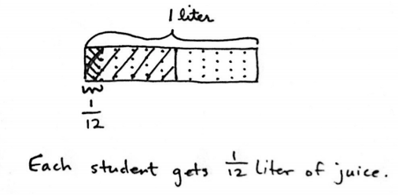 |
Students tin depict record diagrams to make sense of mathematics. Once the record diagram is a tool in their repertoire, they tin use it to solve any number of mathematical problems.








0 Response to "Solve Using A Tape Diagram"
Post a Comment